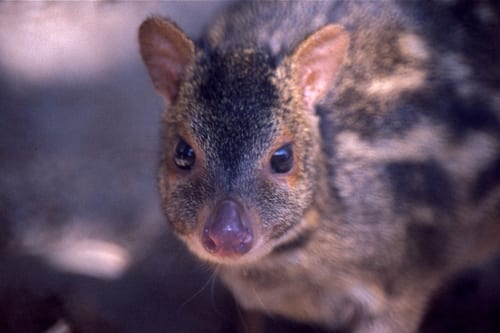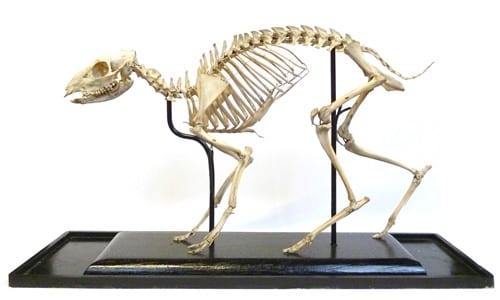Specimen of the Week 233: The mouse-deer skeleton
By Will J Richard, on 1 April 2016
Hello Grant-fans! Will Richard again, taking my turn to bring you specimen of the week. Here goes…
**The mouse-deer skeleton**
Is it a mouse?
This is not a mouse. Chevrotains, or mouse-deer, are tiny, even-toed ungulates. There are ten extant species in the family Tragulidae, all except one of which are found in the forests of South and Southeast Asia. The only exception, the water chevrotain, is native to West Africa. This skeleton is of an Indian spotted chevrotain (Moschiola indica). They typically reach lengths of 60 centimetres and weights of about three kilogrammes. Awww.
Is it a deer?
This is not a deer. Deer are also even-toed ungulates but in the family Cervidae and, in this case, it’s all about family. Mouse-deer (Tragulidae remember) are considered a more basic ruminant form. They have less developed stomach chambers than “true deer”, a more varied diet and many characteristics more akin to non-ruminants. The phrase that keeps cropping up is pig-like. So…
Is it a pig?
This is not a pig. Quick one this. “Pigs” are the pigs, hogs and boars in the family Suidae. This is a chevrotain, a French word literally translating as “little goat. Which begs the question…

Indian spotted chevrotain image by Bernard DUPONT; CC-BY-SA-2.0; via Wikimedia Commons
Is it a goat?
This is not a goat. Goats are the nine species in the genus Capra, and part of the Bovidae (cow and antelope) family.
So, tell me more about this not a mouse-deer-pig-goat?
The Indian spotted chevrotain is reportedly found throughout the forests, fields and rural gardens of India. They are nocturnal, solitary and spend their days hiding in tree hollows, rocky crevices or even just lying in the long grass or leaf-litter where they rely on their camouflaged coat to keep them safe. At night they emerge to feed, foraging on a range of small shrubs, herbs and fallen fruit. They are neither strong nor swift, but rely on their ability to plunge into dense undergrowth and small spaces where potential predators cannot follow. This is not always enough, however, and mouse-deer are a reliable food source for a long list of predatory mammals, reptiles and birds. The females give birth to twins (usually) after a five month gestation period. The young are weaned after about 12 weeks and go on to breed themselves within the first year. Parental care is relatively limited, but then what could their mother actually do when faced with a 50 kilogramme leopard?
Sad times.

Indian spotted chevrotain; image by PJeganathan; CC-BY-SA-3.0; via Wikimedia Commons
References:
http://www.iucnredlist.org/details/136585/0
http://eol.org/pages/7240169/details
Will Richard is the Visitor Services Assistant at the Grant Museum of Zoology
 Close
Close



